Domino's Pizza: International Operations and Challenges Analysis
VerifiedAdded on 2023/01/13
|14
|4226
|35
Report
AI Summary
This report provides an in-depth analysis of Domino's Pizza's operational management, focusing on the challenges it faces during international expansion. The report begins with an executive summary and introduction to operation management, highlighting the transformation model. It then details Domino's background, its approach to operation management, and the characteristics of its operational processes, using models like the 4V model to analyze volume, variety, variation in demand, and visibility. The report examines Domino's performance objectives, including quality, speed, flexibility, dependability, and cost. It identifies structural issues related to people management, process layout, and supply chain, along with infrastructural issues like inventory management and quality gaps. Finally, the report offers analytical and feasible recommendations to overcome these challenges, concluding with a summary of the key findings. This report is designed to give a comprehensive understanding of Domino's operational strategies and the complexities of operating in international markets.

Domino’s
1 | Page
1 | Page
Paraphrase This Document
Need a fresh take? Get an instant paraphrase of this document with our AI Paraphraser
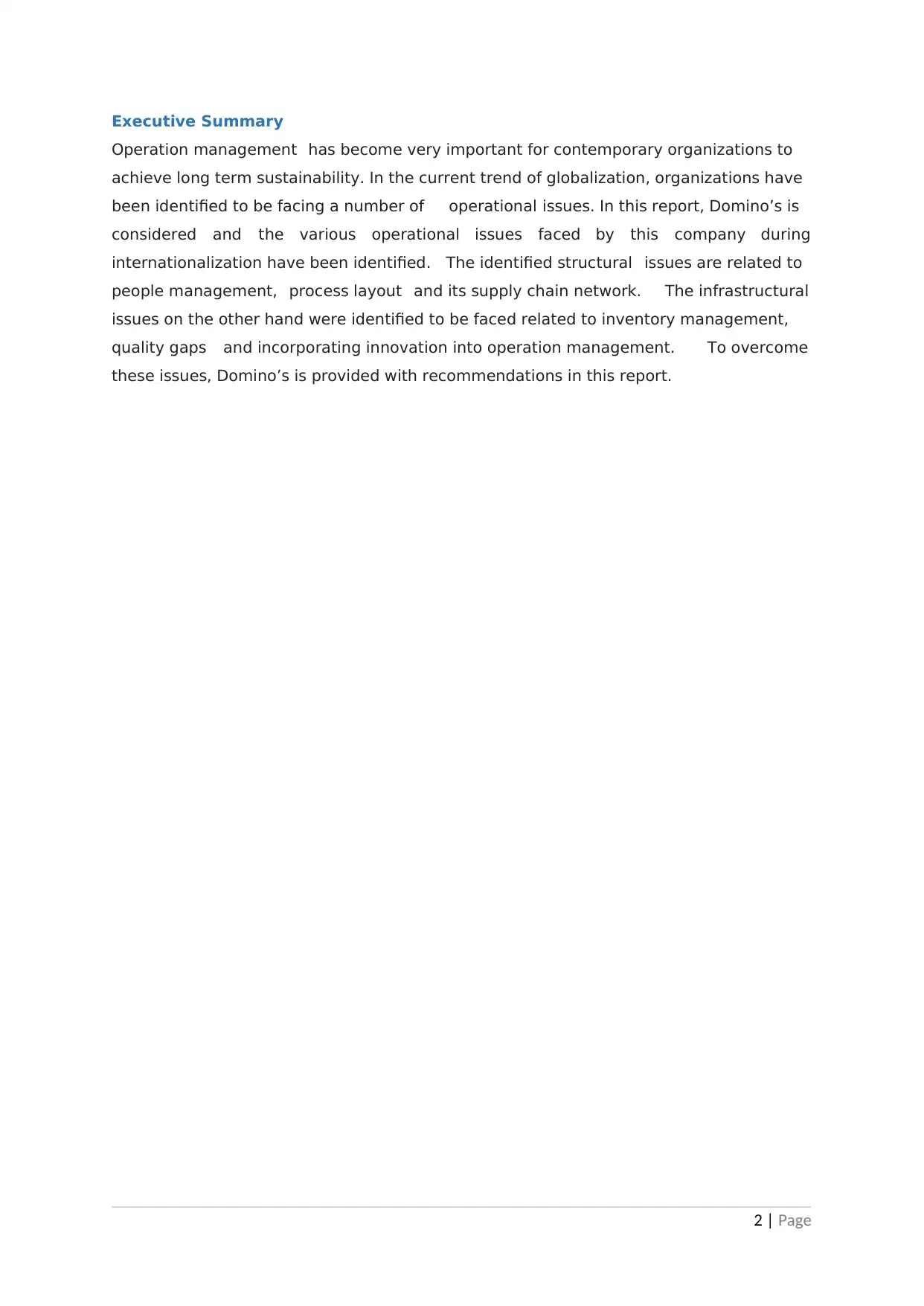
Executive Summary
Operation management has become very important for contemporary organizations to
achieve long term sustainability. In the current trend of globalization, organizations have
been identified to be facing a number of operational issues. In this report, Domino’s is
considered and the various operational issues faced by this company during
internationalization have been identified. The identified structural issues are related to
people management, process layout and its supply chain network. The infrastructural
issues on the other hand were identified to be faced related to inventory management,
quality gaps and incorporating innovation into operation management. To overcome
these issues, Domino’s is provided with recommendations in this report.
2 | Page
Operation management has become very important for contemporary organizations to
achieve long term sustainability. In the current trend of globalization, organizations have
been identified to be facing a number of operational issues. In this report, Domino’s is
considered and the various operational issues faced by this company during
internationalization have been identified. The identified structural issues are related to
people management, process layout and its supply chain network. The infrastructural
issues on the other hand were identified to be faced related to inventory management,
quality gaps and incorporating innovation into operation management. To overcome
these issues, Domino’s is provided with recommendations in this report.
2 | Page
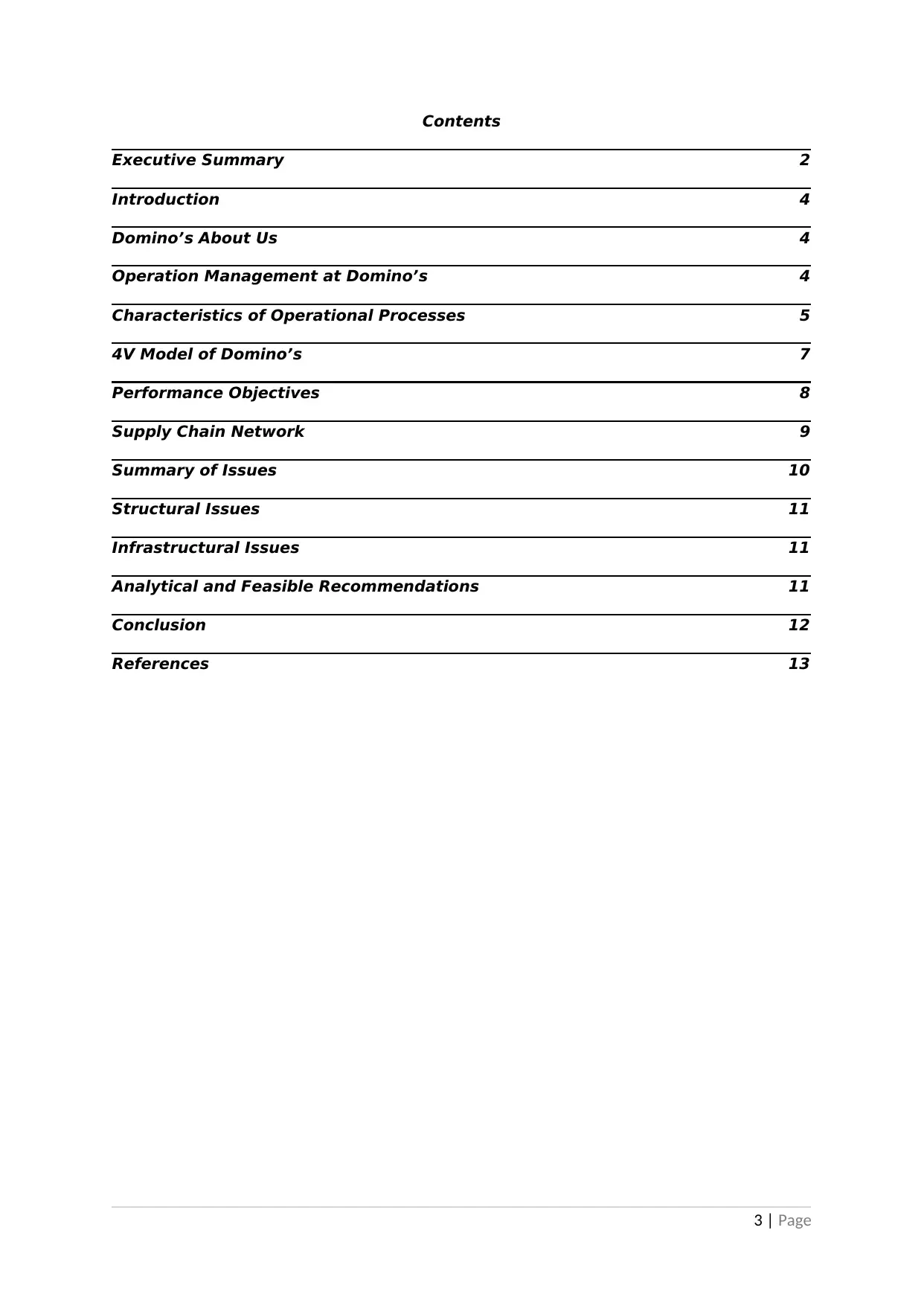
Contents
Executive Summary 2
Introduction 4
Domino’s About Us 4
Operation Management at Domino’s 4
Characteristics of Operational Processes 5
4V Model of Domino’s 7
Performance Objectives 8
Supply Chain Network 9
Summary of Issues 10
Structural Issues 11
Infrastructural Issues 11
Analytical and Feasible Recommendations 11
Conclusion 12
References 13
3 | Page
Executive Summary 2
Introduction 4
Domino’s About Us 4
Operation Management at Domino’s 4
Characteristics of Operational Processes 5
4V Model of Domino’s 7
Performance Objectives 8
Supply Chain Network 9
Summary of Issues 10
Structural Issues 11
Infrastructural Issues 11
Analytical and Feasible Recommendations 11
Conclusion 12
References 13
3 | Page
⊘ This is a preview!⊘
Do you want full access?
Subscribe today to unlock all pages.

Trusted by 1+ million students worldwide
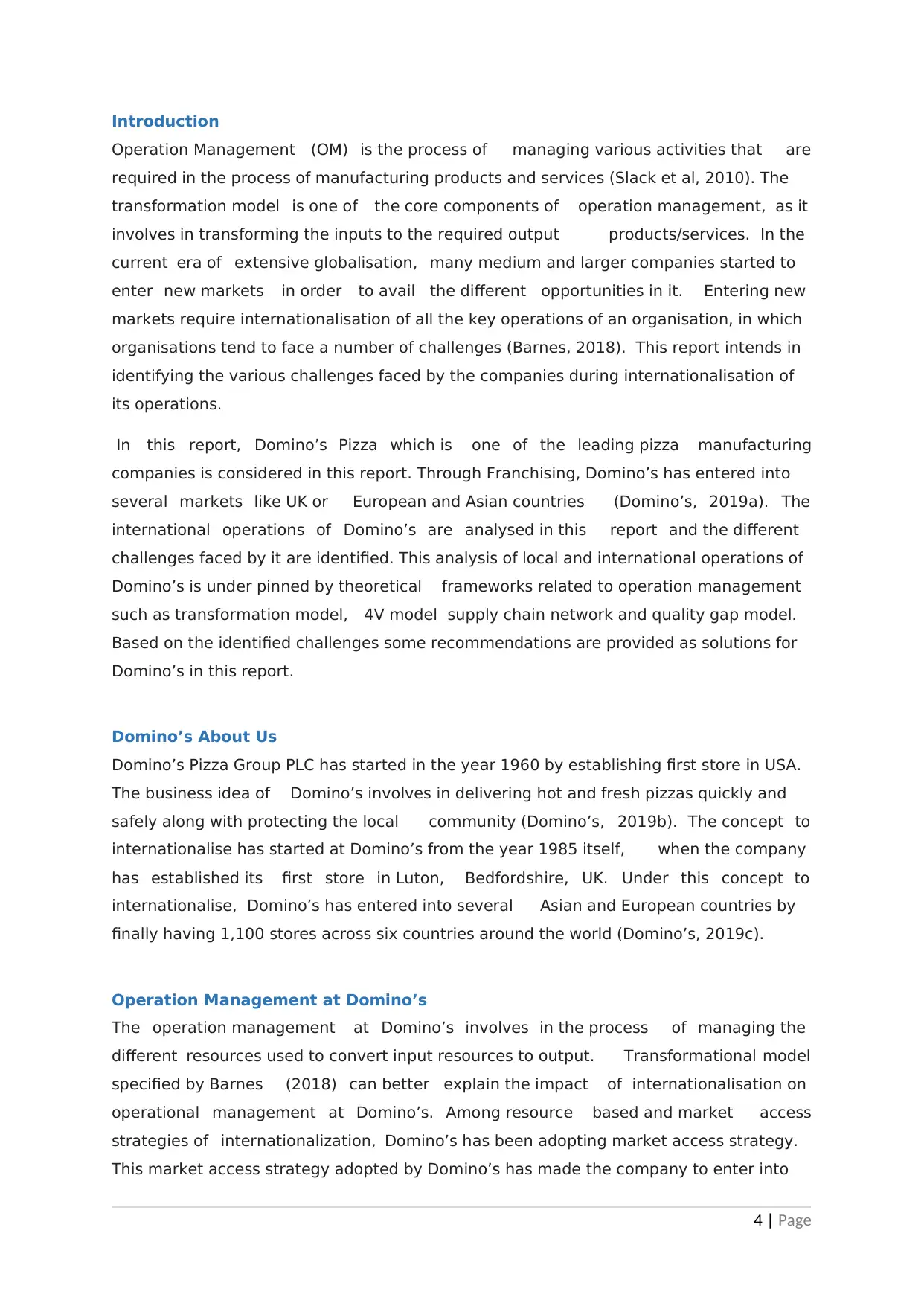
Introduction
Operation Management (OM) is the process of managing various activities that are
required in the process of manufacturing products and services (Slack et al, 2010). The
transformation model is one of the core components of operation management, as it
involves in transforming the inputs to the required output products/services. In the
current era of extensive globalisation, many medium and larger companies started to
enter new markets in order to avail the different opportunities in it. Entering new
markets require internationalisation of all the key operations of an organisation, in which
organisations tend to face a number of challenges (Barnes, 2018). This report intends in
identifying the various challenges faced by the companies during internationalisation of
its operations.
In this report, Domino’s Pizza which is one of the leading pizza manufacturing
companies is considered in this report. Through Franchising, Domino’s has entered into
several markets like UK or European and Asian countries (Domino’s, 2019a). The
international operations of Domino’s are analysed in this report and the different
challenges faced by it are identified. This analysis of local and international operations of
Domino’s is under pinned by theoretical frameworks related to operation management
such as transformation model, 4V model supply chain network and quality gap model.
Based on the identified challenges some recommendations are provided as solutions for
Domino’s in this report.
Domino’s About Us
Domino’s Pizza Group PLC has started in the year 1960 by establishing first store in USA.
The business idea of Domino’s involves in delivering hot and fresh pizzas quickly and
safely along with protecting the local community (Domino’s, 2019b). The concept to
internationalise has started at Domino’s from the year 1985 itself, when the company
has established its first store in Luton, Bedfordshire, UK. Under this concept to
internationalise, Domino’s has entered into several Asian and European countries by
finally having 1,100 stores across six countries around the world (Domino’s, 2019c).
Operation Management at Domino’s
The operation management at Domino’s involves in the process of managing the
different resources used to convert input resources to output. Transformational model
specified by Barnes (2018) can better explain the impact of internationalisation on
operational management at Domino’s. Among resource based and market access
strategies of internationalization, Domino’s has been adopting market access strategy.
This market access strategy adopted by Domino’s has made the company to enter into
4 | Page
Operation Management (OM) is the process of managing various activities that are
required in the process of manufacturing products and services (Slack et al, 2010). The
transformation model is one of the core components of operation management, as it
involves in transforming the inputs to the required output products/services. In the
current era of extensive globalisation, many medium and larger companies started to
enter new markets in order to avail the different opportunities in it. Entering new
markets require internationalisation of all the key operations of an organisation, in which
organisations tend to face a number of challenges (Barnes, 2018). This report intends in
identifying the various challenges faced by the companies during internationalisation of
its operations.
In this report, Domino’s Pizza which is one of the leading pizza manufacturing
companies is considered in this report. Through Franchising, Domino’s has entered into
several markets like UK or European and Asian countries (Domino’s, 2019a). The
international operations of Domino’s are analysed in this report and the different
challenges faced by it are identified. This analysis of local and international operations of
Domino’s is under pinned by theoretical frameworks related to operation management
such as transformation model, 4V model supply chain network and quality gap model.
Based on the identified challenges some recommendations are provided as solutions for
Domino’s in this report.
Domino’s About Us
Domino’s Pizza Group PLC has started in the year 1960 by establishing first store in USA.
The business idea of Domino’s involves in delivering hot and fresh pizzas quickly and
safely along with protecting the local community (Domino’s, 2019b). The concept to
internationalise has started at Domino’s from the year 1985 itself, when the company
has established its first store in Luton, Bedfordshire, UK. Under this concept to
internationalise, Domino’s has entered into several Asian and European countries by
finally having 1,100 stores across six countries around the world (Domino’s, 2019c).
Operation Management at Domino’s
The operation management at Domino’s involves in the process of managing the
different resources used to convert input resources to output. Transformational model
specified by Barnes (2018) can better explain the impact of internationalisation on
operational management at Domino’s. Among resource based and market access
strategies of internationalization, Domino’s has been adopting market access strategy.
This market access strategy adopted by Domino’s has made the company to enter into
4 | Page
Paraphrase This Document
Need a fresh take? Get an instant paraphrase of this document with our AI Paraphraser
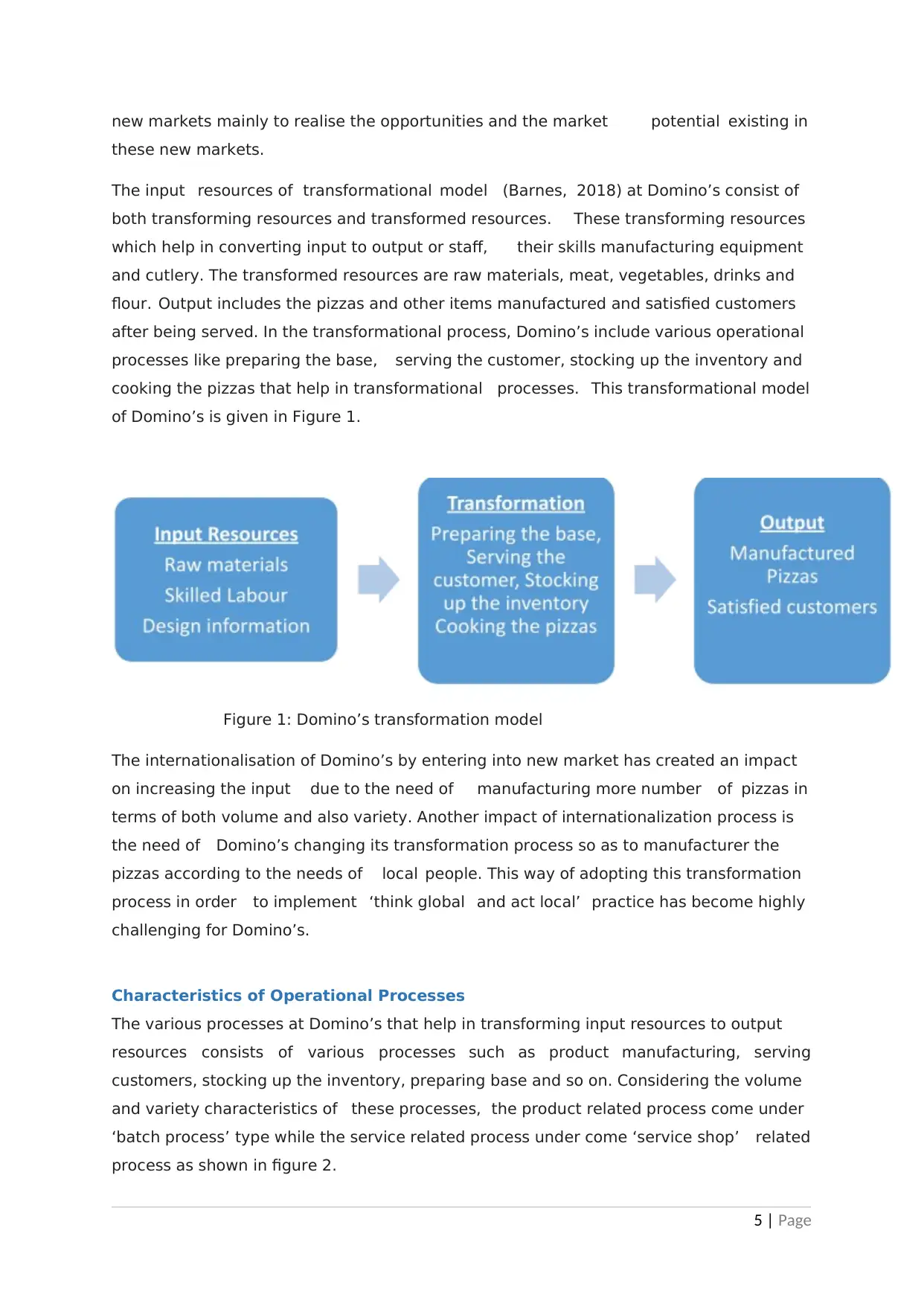
new markets mainly to realise the opportunities and the market potential existing in
these new markets.
The input resources of transformational model (Barnes, 2018) at Domino’s consist of
both transforming resources and transformed resources. These transforming resources
which help in converting input to output or staff, their skills manufacturing equipment
and cutlery. The transformed resources are raw materials, meat, vegetables, drinks and
flour. Output includes the pizzas and other items manufactured and satisfied customers
after being served. In the transformational process, Domino’s include various operational
processes like preparing the base, serving the customer, stocking up the inventory and
cooking the pizzas that help in transformational processes. This transformational model
of Domino’s is given in Figure 1.
Figure 1: Domino’s transformation model
The internationalisation of Domino’s by entering into new market has created an impact
on increasing the input due to the need of manufacturing more number of pizzas in
terms of both volume and also variety. Another impact of internationalization process is
the need of Domino’s changing its transformation process so as to manufacturer the
pizzas according to the needs of local people. This way of adopting this transformation
process in order to implement ‘think global and act local’ practice has become highly
challenging for Domino’s.
Characteristics of Operational Processes
The various processes at Domino’s that help in transforming input resources to output
resources consists of various processes such as product manufacturing, serving
customers, stocking up the inventory, preparing base and so on. Considering the volume
and variety characteristics of these processes, the product related process come under
‘batch process’ type while the service related process under come ‘service shop’ related
process as shown in figure 2.
5 | Page
these new markets.
The input resources of transformational model (Barnes, 2018) at Domino’s consist of
both transforming resources and transformed resources. These transforming resources
which help in converting input to output or staff, their skills manufacturing equipment
and cutlery. The transformed resources are raw materials, meat, vegetables, drinks and
flour. Output includes the pizzas and other items manufactured and satisfied customers
after being served. In the transformational process, Domino’s include various operational
processes like preparing the base, serving the customer, stocking up the inventory and
cooking the pizzas that help in transformational processes. This transformational model
of Domino’s is given in Figure 1.
Figure 1: Domino’s transformation model
The internationalisation of Domino’s by entering into new market has created an impact
on increasing the input due to the need of manufacturing more number of pizzas in
terms of both volume and also variety. Another impact of internationalization process is
the need of Domino’s changing its transformation process so as to manufacturer the
pizzas according to the needs of local people. This way of adopting this transformation
process in order to implement ‘think global and act local’ practice has become highly
challenging for Domino’s.
Characteristics of Operational Processes
The various processes at Domino’s that help in transforming input resources to output
resources consists of various processes such as product manufacturing, serving
customers, stocking up the inventory, preparing base and so on. Considering the volume
and variety characteristics of these processes, the product related process come under
‘batch process’ type while the service related process under come ‘service shop’ related
process as shown in figure 2.
5 | Page

Figure 2: Process characteristics of Domino’s pizza
Due to internationalisation of Domino’s operations, the volume of pizzas that must be
manufactured has increased along with variety of pizzas to be manufactured. This
resulted in the company adopting batch process. However, implementing batch process
requires proper planning in order to balance between volume and variety of the product
required. To support this batch process, Domino’s is currently adopting assembly line
approach with the product based layout existing in the organization (Lopez, 2018).
However, internalization has made the company to choose different layouts for the
different stores located across the world mainly due to the difference in demand,
capacity and product varieties needed to meet the needs of local people.
For instance, Pizza base is an essential item for any kind of pizza that is being ordered.
Based on this analysis, Domino’s can standardise the preparation of Pizza base by
identifying the estimated demand during a day. This way of planning to implement batch
process is certainly challenging for Domino’s during internationalisation of its operations
as it requires the company to estimate the demand, identify the required inventory levels
and identify the activities that have to be standardized based on the demand from the
local customers. When Domino’s enters newly into a new market like India, the company
will not be able to access the previous sales report, which makes the company face
challenges related to inventory management, demand forecasting and in planning the
activities that must be systematized for food preparation under ‘batch process’.
6 | Page
Due to internationalisation of Domino’s operations, the volume of pizzas that must be
manufactured has increased along with variety of pizzas to be manufactured. This
resulted in the company adopting batch process. However, implementing batch process
requires proper planning in order to balance between volume and variety of the product
required. To support this batch process, Domino’s is currently adopting assembly line
approach with the product based layout existing in the organization (Lopez, 2018).
However, internalization has made the company to choose different layouts for the
different stores located across the world mainly due to the difference in demand,
capacity and product varieties needed to meet the needs of local people.
For instance, Pizza base is an essential item for any kind of pizza that is being ordered.
Based on this analysis, Domino’s can standardise the preparation of Pizza base by
identifying the estimated demand during a day. This way of planning to implement batch
process is certainly challenging for Domino’s during internationalisation of its operations
as it requires the company to estimate the demand, identify the required inventory levels
and identify the activities that have to be standardized based on the demand from the
local customers. When Domino’s enters newly into a new market like India, the company
will not be able to access the previous sales report, which makes the company face
challenges related to inventory management, demand forecasting and in planning the
activities that must be systematized for food preparation under ‘batch process’.
6 | Page
⊘ This is a preview!⊘
Do you want full access?
Subscribe today to unlock all pages.

Trusted by 1+ million students worldwide
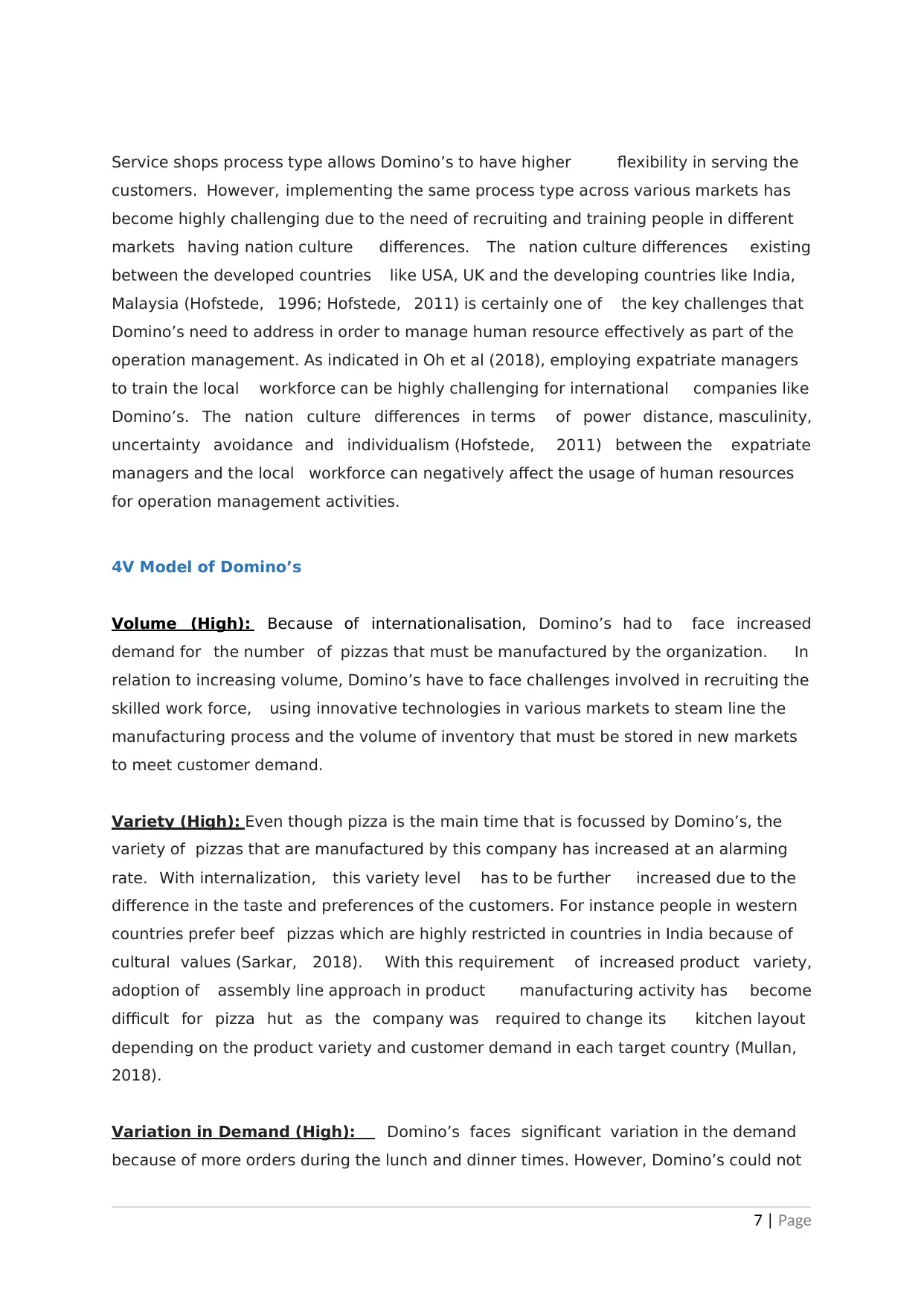
Service shops process type allows Domino’s to have higher flexibility in serving the
customers. However, implementing the same process type across various markets has
become highly challenging due to the need of recruiting and training people in different
markets having nation culture differences. The nation culture differences existing
between the developed countries like USA, UK and the developing countries like India,
Malaysia (Hofstede, 1996; Hofstede, 2011) is certainly one of the key challenges that
Domino’s need to address in order to manage human resource effectively as part of the
operation management. As indicated in Oh et al (2018), employing expatriate managers
to train the local workforce can be highly challenging for international companies like
Domino’s. The nation culture differences in terms of power distance, masculinity,
uncertainty avoidance and individualism (Hofstede, 2011) between the expatriate
managers and the local workforce can negatively affect the usage of human resources
for operation management activities.
4V Model of Domino’s
Volume (High): Because of internationalisation, Domino’s had to face increased
demand for the number of pizzas that must be manufactured by the organization. In
relation to increasing volume, Domino’s have to face challenges involved in recruiting the
skilled work force, using innovative technologies in various markets to steam line the
manufacturing process and the volume of inventory that must be stored in new markets
to meet customer demand.
Variety (High): Even though pizza is the main time that is focussed by Domino’s, the
variety of pizzas that are manufactured by this company has increased at an alarming
rate. With internalization, this variety level has to be further increased due to the
difference in the taste and preferences of the customers. For instance people in western
countries prefer beef pizzas which are highly restricted in countries in India because of
cultural values (Sarkar, 2018). With this requirement of increased product variety,
adoption of assembly line approach in product manufacturing activity has become
difficult for pizza hut as the company was required to change its kitchen layout
depending on the product variety and customer demand in each target country (Mullan,
2018).
Variation in Demand (High): Domino’s faces significant variation in the demand
because of more orders during the lunch and dinner times. However, Domino’s could not
7 | Page
customers. However, implementing the same process type across various markets has
become highly challenging due to the need of recruiting and training people in different
markets having nation culture differences. The nation culture differences existing
between the developed countries like USA, UK and the developing countries like India,
Malaysia (Hofstede, 1996; Hofstede, 2011) is certainly one of the key challenges that
Domino’s need to address in order to manage human resource effectively as part of the
operation management. As indicated in Oh et al (2018), employing expatriate managers
to train the local workforce can be highly challenging for international companies like
Domino’s. The nation culture differences in terms of power distance, masculinity,
uncertainty avoidance and individualism (Hofstede, 2011) between the expatriate
managers and the local workforce can negatively affect the usage of human resources
for operation management activities.
4V Model of Domino’s
Volume (High): Because of internationalisation, Domino’s had to face increased
demand for the number of pizzas that must be manufactured by the organization. In
relation to increasing volume, Domino’s have to face challenges involved in recruiting the
skilled work force, using innovative technologies in various markets to steam line the
manufacturing process and the volume of inventory that must be stored in new markets
to meet customer demand.
Variety (High): Even though pizza is the main time that is focussed by Domino’s, the
variety of pizzas that are manufactured by this company has increased at an alarming
rate. With internalization, this variety level has to be further increased due to the
difference in the taste and preferences of the customers. For instance people in western
countries prefer beef pizzas which are highly restricted in countries in India because of
cultural values (Sarkar, 2018). With this requirement of increased product variety,
adoption of assembly line approach in product manufacturing activity has become
difficult for pizza hut as the company was required to change its kitchen layout
depending on the product variety and customer demand in each target country (Mullan,
2018).
Variation in Demand (High): Domino’s faces significant variation in the demand
because of more orders during the lunch and dinner times. However, Domino’s could not
7 | Page
Paraphrase This Document
Need a fresh take? Get an instant paraphrase of this document with our AI Paraphraser

implement the same demand fluctuations techniques in new markets due to the
differences in eating life style of people across different countries in the world (Sarkar,
2018). For instance, Chinese are known to eat only 2 times a day while Indians tend to
consume food 3 times a day (Miller, 2017). This result in Domino’s facing challenges
related to demand forecasting as it must be done uniquely for each different market
rather than using a standard approach.
Visibility Degree (High to Low): The visibility of manufacturing activities at Domino’s
differs from high to low based on which consumers consume the product. For instance,
visibility level for consumers choosing take away is high and for consumers who have
chosen home delivery option is low. In this aspect, Domino’s is required to consider the
quality expectations of customers across different countries in the world due to the
existence of differences in quality management standards in different countries. For
instance, the food safety regulations in UK are comparatively stricter as those in other
countries like India, Malaysia and Pakistan (Edmunds, 2017).
Performance Objectives
To identify the various structural and infrastructural issues faced by Domino’s, the
performance of key operations of this company is evaluated in terms of quality, speed,
flexibility, dependability, cost. The polar diagram given in Figure 3 gives the performance
objectives of Domino’s.
Figure 3: Polar diagram of Domino’s
8 | Page
differences in eating life style of people across different countries in the world (Sarkar,
2018). For instance, Chinese are known to eat only 2 times a day while Indians tend to
consume food 3 times a day (Miller, 2017). This result in Domino’s facing challenges
related to demand forecasting as it must be done uniquely for each different market
rather than using a standard approach.
Visibility Degree (High to Low): The visibility of manufacturing activities at Domino’s
differs from high to low based on which consumers consume the product. For instance,
visibility level for consumers choosing take away is high and for consumers who have
chosen home delivery option is low. In this aspect, Domino’s is required to consider the
quality expectations of customers across different countries in the world due to the
existence of differences in quality management standards in different countries. For
instance, the food safety regulations in UK are comparatively stricter as those in other
countries like India, Malaysia and Pakistan (Edmunds, 2017).
Performance Objectives
To identify the various structural and infrastructural issues faced by Domino’s, the
performance of key operations of this company is evaluated in terms of quality, speed,
flexibility, dependability, cost. The polar diagram given in Figure 3 gives the performance
objectives of Domino’s.
Figure 3: Polar diagram of Domino’s
8 | Page
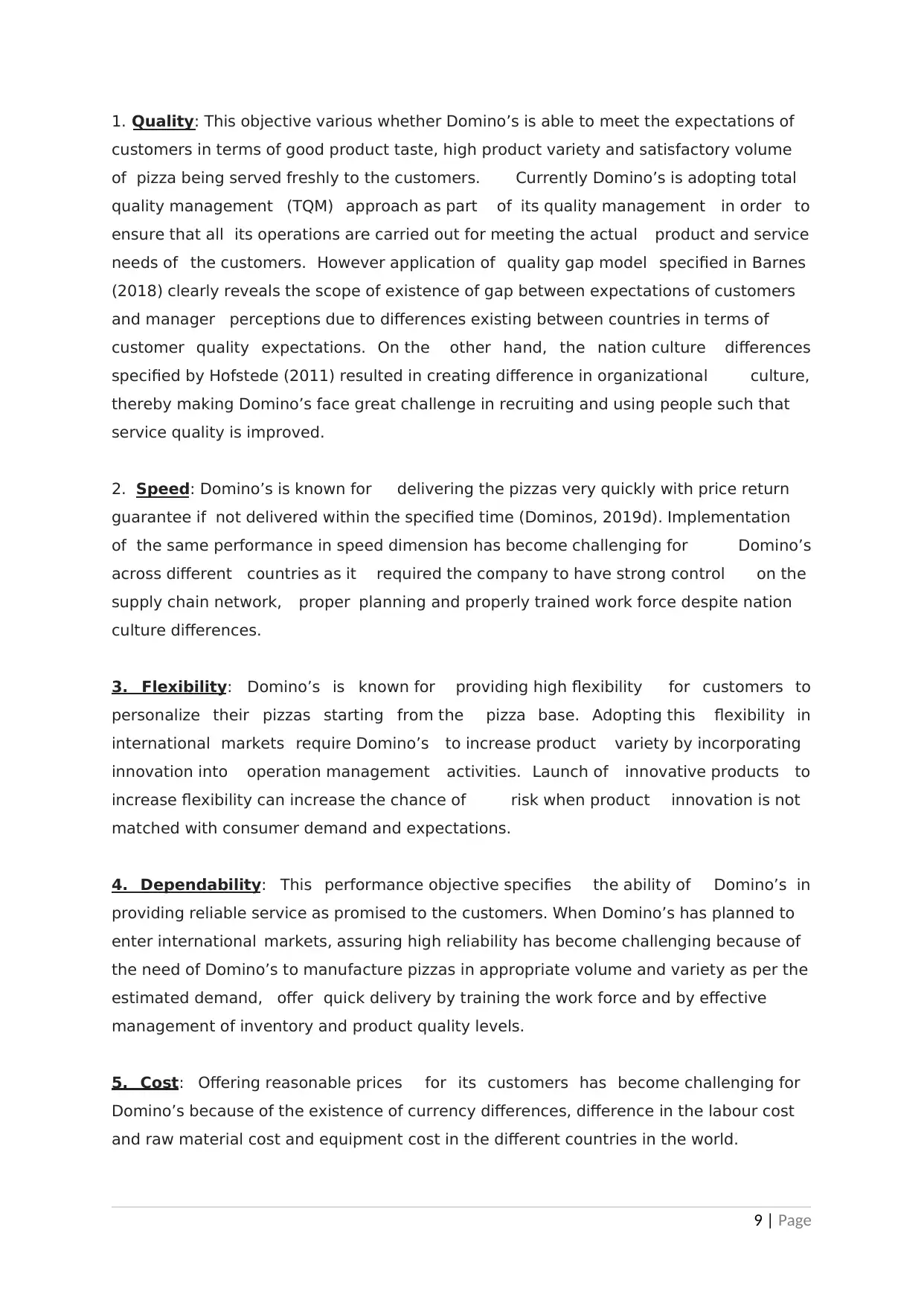
1. Quality: This objective various whether Domino’s is able to meet the expectations of
customers in terms of good product taste, high product variety and satisfactory volume
of pizza being served freshly to the customers. Currently Domino’s is adopting total
quality management (TQM) approach as part of its quality management in order to
ensure that all its operations are carried out for meeting the actual product and service
needs of the customers. However application of quality gap model specified in Barnes
(2018) clearly reveals the scope of existence of gap between expectations of customers
and manager perceptions due to differences existing between countries in terms of
customer quality expectations. On the other hand, the nation culture differences
specified by Hofstede (2011) resulted in creating difference in organizational culture,
thereby making Domino’s face great challenge in recruiting and using people such that
service quality is improved.
2. Speed: Domino’s is known for delivering the pizzas very quickly with price return
guarantee if not delivered within the specified time (Dominos, 2019d). Implementation
of the same performance in speed dimension has become challenging for Domino’s
across different countries as it required the company to have strong control on the
supply chain network, proper planning and properly trained work force despite nation
culture differences.
3. Flexibility: Domino’s is known for providing high flexibility for customers to
personalize their pizzas starting from the pizza base. Adopting this flexibility in
international markets require Domino’s to increase product variety by incorporating
innovation into operation management activities. Launch of innovative products to
increase flexibility can increase the chance of risk when product innovation is not
matched with consumer demand and expectations.
4. Dependability: This performance objective specifies the ability of Domino’s in
providing reliable service as promised to the customers. When Domino’s has planned to
enter international markets, assuring high reliability has become challenging because of
the need of Domino’s to manufacture pizzas in appropriate volume and variety as per the
estimated demand, offer quick delivery by training the work force and by effective
management of inventory and product quality levels.
5. Cost: Offering reasonable prices for its customers has become challenging for
Domino’s because of the existence of currency differences, difference in the labour cost
and raw material cost and equipment cost in the different countries in the world.
9 | Page
customers in terms of good product taste, high product variety and satisfactory volume
of pizza being served freshly to the customers. Currently Domino’s is adopting total
quality management (TQM) approach as part of its quality management in order to
ensure that all its operations are carried out for meeting the actual product and service
needs of the customers. However application of quality gap model specified in Barnes
(2018) clearly reveals the scope of existence of gap between expectations of customers
and manager perceptions due to differences existing between countries in terms of
customer quality expectations. On the other hand, the nation culture differences
specified by Hofstede (2011) resulted in creating difference in organizational culture,
thereby making Domino’s face great challenge in recruiting and using people such that
service quality is improved.
2. Speed: Domino’s is known for delivering the pizzas very quickly with price return
guarantee if not delivered within the specified time (Dominos, 2019d). Implementation
of the same performance in speed dimension has become challenging for Domino’s
across different countries as it required the company to have strong control on the
supply chain network, proper planning and properly trained work force despite nation
culture differences.
3. Flexibility: Domino’s is known for providing high flexibility for customers to
personalize their pizzas starting from the pizza base. Adopting this flexibility in
international markets require Domino’s to increase product variety by incorporating
innovation into operation management activities. Launch of innovative products to
increase flexibility can increase the chance of risk when product innovation is not
matched with consumer demand and expectations.
4. Dependability: This performance objective specifies the ability of Domino’s in
providing reliable service as promised to the customers. When Domino’s has planned to
enter international markets, assuring high reliability has become challenging because of
the need of Domino’s to manufacture pizzas in appropriate volume and variety as per the
estimated demand, offer quick delivery by training the work force and by effective
management of inventory and product quality levels.
5. Cost: Offering reasonable prices for its customers has become challenging for
Domino’s because of the existence of currency differences, difference in the labour cost
and raw material cost and equipment cost in the different countries in the world.
9 | Page
⊘ This is a preview!⊘
Do you want full access?
Subscribe today to unlock all pages.

Trusted by 1+ million students worldwide
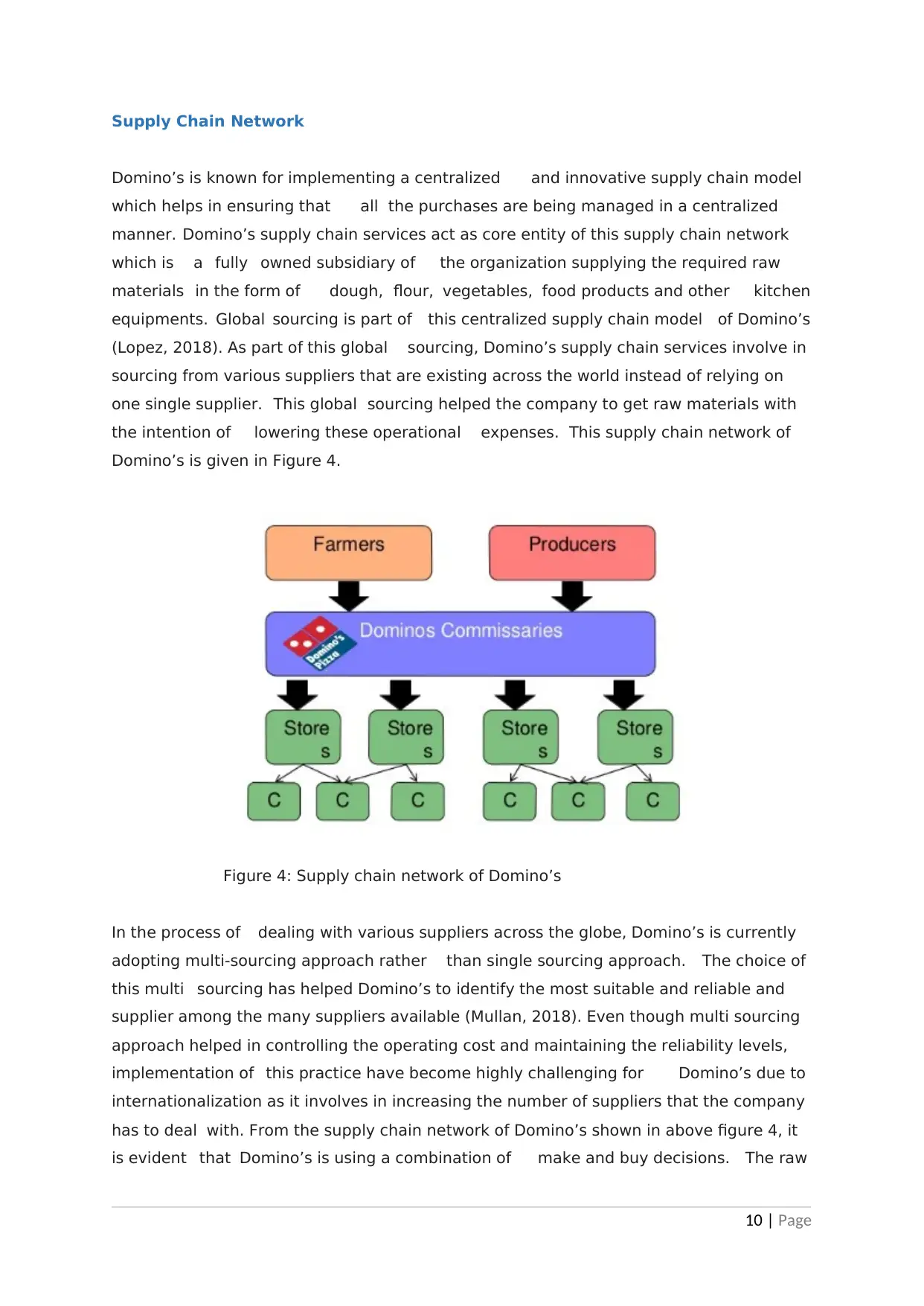
Supply Chain Network
Domino’s is known for implementing a centralized and innovative supply chain model
which helps in ensuring that all the purchases are being managed in a centralized
manner. Domino’s supply chain services act as core entity of this supply chain network
which is a fully owned subsidiary of the organization supplying the required raw
materials in the form of dough, flour, vegetables, food products and other kitchen
equipments. Global sourcing is part of this centralized supply chain model of Domino’s
(Lopez, 2018). As part of this global sourcing, Domino’s supply chain services involve in
sourcing from various suppliers that are existing across the world instead of relying on
one single supplier. This global sourcing helped the company to get raw materials with
the intention of lowering these operational expenses. This supply chain network of
Domino’s is given in Figure 4.
Figure 4: Supply chain network of Domino’s
In the process of dealing with various suppliers across the globe, Domino’s is currently
adopting multi-sourcing approach rather than single sourcing approach. The choice of
this multi sourcing has helped Domino’s to identify the most suitable and reliable and
supplier among the many suppliers available (Mullan, 2018). Even though multi sourcing
approach helped in controlling the operating cost and maintaining the reliability levels,
implementation of this practice have become highly challenging for Domino’s due to
internationalization as it involves in increasing the number of suppliers that the company
has to deal with. From the supply chain network of Domino’s shown in above figure 4, it
is evident that Domino’s is using a combination of make and buy decisions. The raw
10 | Page
Domino’s is known for implementing a centralized and innovative supply chain model
which helps in ensuring that all the purchases are being managed in a centralized
manner. Domino’s supply chain services act as core entity of this supply chain network
which is a fully owned subsidiary of the organization supplying the required raw
materials in the form of dough, flour, vegetables, food products and other kitchen
equipments. Global sourcing is part of this centralized supply chain model of Domino’s
(Lopez, 2018). As part of this global sourcing, Domino’s supply chain services involve in
sourcing from various suppliers that are existing across the world instead of relying on
one single supplier. This global sourcing helped the company to get raw materials with
the intention of lowering these operational expenses. This supply chain network of
Domino’s is given in Figure 4.
Figure 4: Supply chain network of Domino’s
In the process of dealing with various suppliers across the globe, Domino’s is currently
adopting multi-sourcing approach rather than single sourcing approach. The choice of
this multi sourcing has helped Domino’s to identify the most suitable and reliable and
supplier among the many suppliers available (Mullan, 2018). Even though multi sourcing
approach helped in controlling the operating cost and maintaining the reliability levels,
implementation of this practice have become highly challenging for Domino’s due to
internationalization as it involves in increasing the number of suppliers that the company
has to deal with. From the supply chain network of Domino’s shown in above figure 4, it
is evident that Domino’s is using a combination of make and buy decisions. The raw
10 | Page
Paraphrase This Document
Need a fresh take? Get an instant paraphrase of this document with our AI Paraphraser
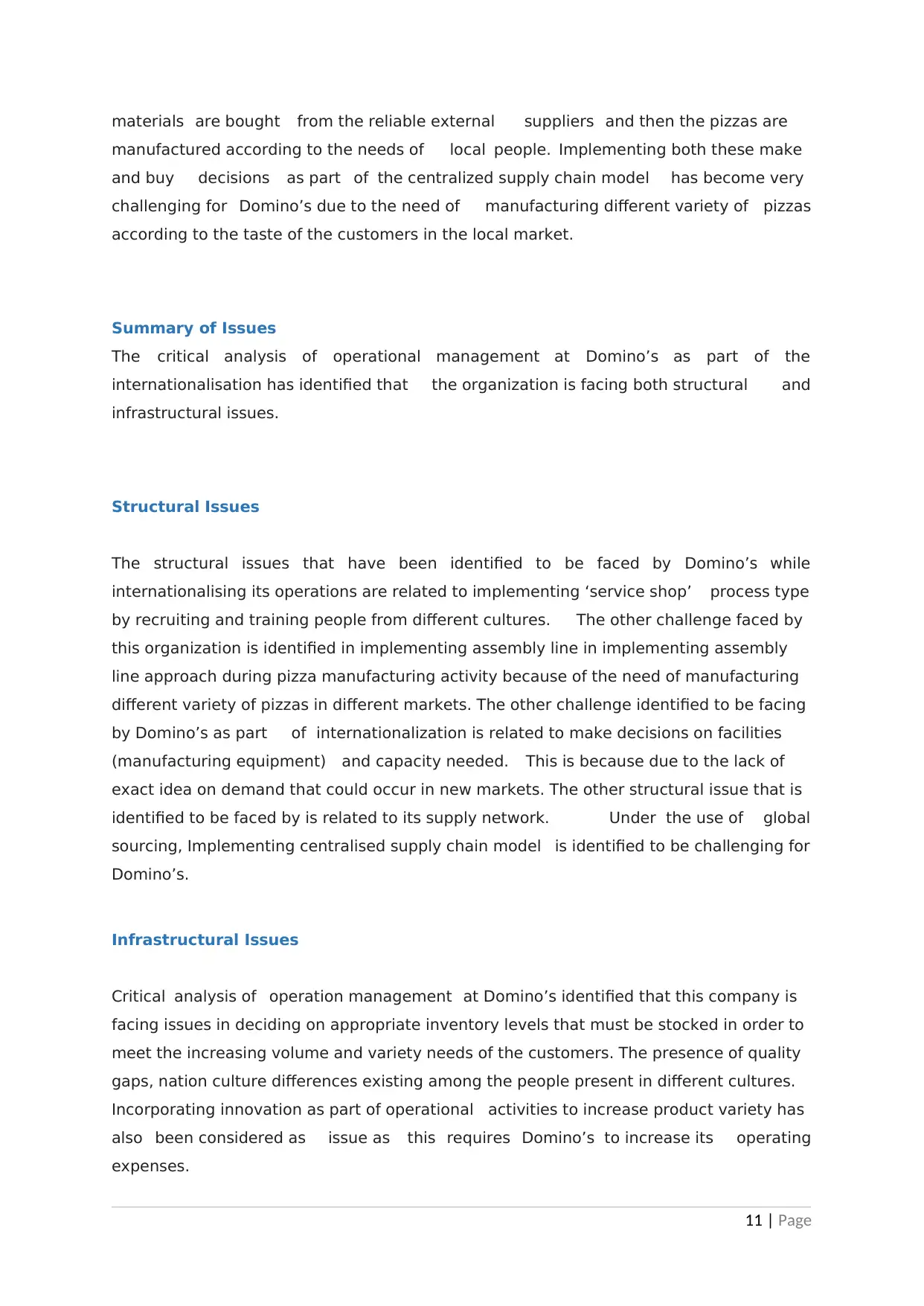
materials are bought from the reliable external suppliers and then the pizzas are
manufactured according to the needs of local people. Implementing both these make
and buy decisions as part of the centralized supply chain model has become very
challenging for Domino’s due to the need of manufacturing different variety of pizzas
according to the taste of the customers in the local market.
Summary of Issues
The critical analysis of operational management at Domino’s as part of the
internationalisation has identified that the organization is facing both structural and
infrastructural issues.
Structural Issues
The structural issues that have been identified to be faced by Domino’s while
internationalising its operations are related to implementing ‘service shop’ process type
by recruiting and training people from different cultures. The other challenge faced by
this organization is identified in implementing assembly line in implementing assembly
line approach during pizza manufacturing activity because of the need of manufacturing
different variety of pizzas in different markets. The other challenge identified to be facing
by Domino’s as part of internationalization is related to make decisions on facilities
(manufacturing equipment) and capacity needed. This is because due to the lack of
exact idea on demand that could occur in new markets. The other structural issue that is
identified to be faced by is related to its supply network. Under the use of global
sourcing, Implementing centralised supply chain model is identified to be challenging for
Domino’s.
Infrastructural Issues
Critical analysis of operation management at Domino’s identified that this company is
facing issues in deciding on appropriate inventory levels that must be stocked in order to
meet the increasing volume and variety needs of the customers. The presence of quality
gaps, nation culture differences existing among the people present in different cultures.
Incorporating innovation as part of operational activities to increase product variety has
also been considered as issue as this requires Domino’s to increase its operating
expenses.
11 | Page
manufactured according to the needs of local people. Implementing both these make
and buy decisions as part of the centralized supply chain model has become very
challenging for Domino’s due to the need of manufacturing different variety of pizzas
according to the taste of the customers in the local market.
Summary of Issues
The critical analysis of operational management at Domino’s as part of the
internationalisation has identified that the organization is facing both structural and
infrastructural issues.
Structural Issues
The structural issues that have been identified to be faced by Domino’s while
internationalising its operations are related to implementing ‘service shop’ process type
by recruiting and training people from different cultures. The other challenge faced by
this organization is identified in implementing assembly line in implementing assembly
line approach during pizza manufacturing activity because of the need of manufacturing
different variety of pizzas in different markets. The other challenge identified to be facing
by Domino’s as part of internationalization is related to make decisions on facilities
(manufacturing equipment) and capacity needed. This is because due to the lack of
exact idea on demand that could occur in new markets. The other structural issue that is
identified to be faced by is related to its supply network. Under the use of global
sourcing, Implementing centralised supply chain model is identified to be challenging for
Domino’s.
Infrastructural Issues
Critical analysis of operation management at Domino’s identified that this company is
facing issues in deciding on appropriate inventory levels that must be stocked in order to
meet the increasing volume and variety needs of the customers. The presence of quality
gaps, nation culture differences existing among the people present in different cultures.
Incorporating innovation as part of operational activities to increase product variety has
also been considered as issue as this requires Domino’s to increase its operating
expenses.
11 | Page
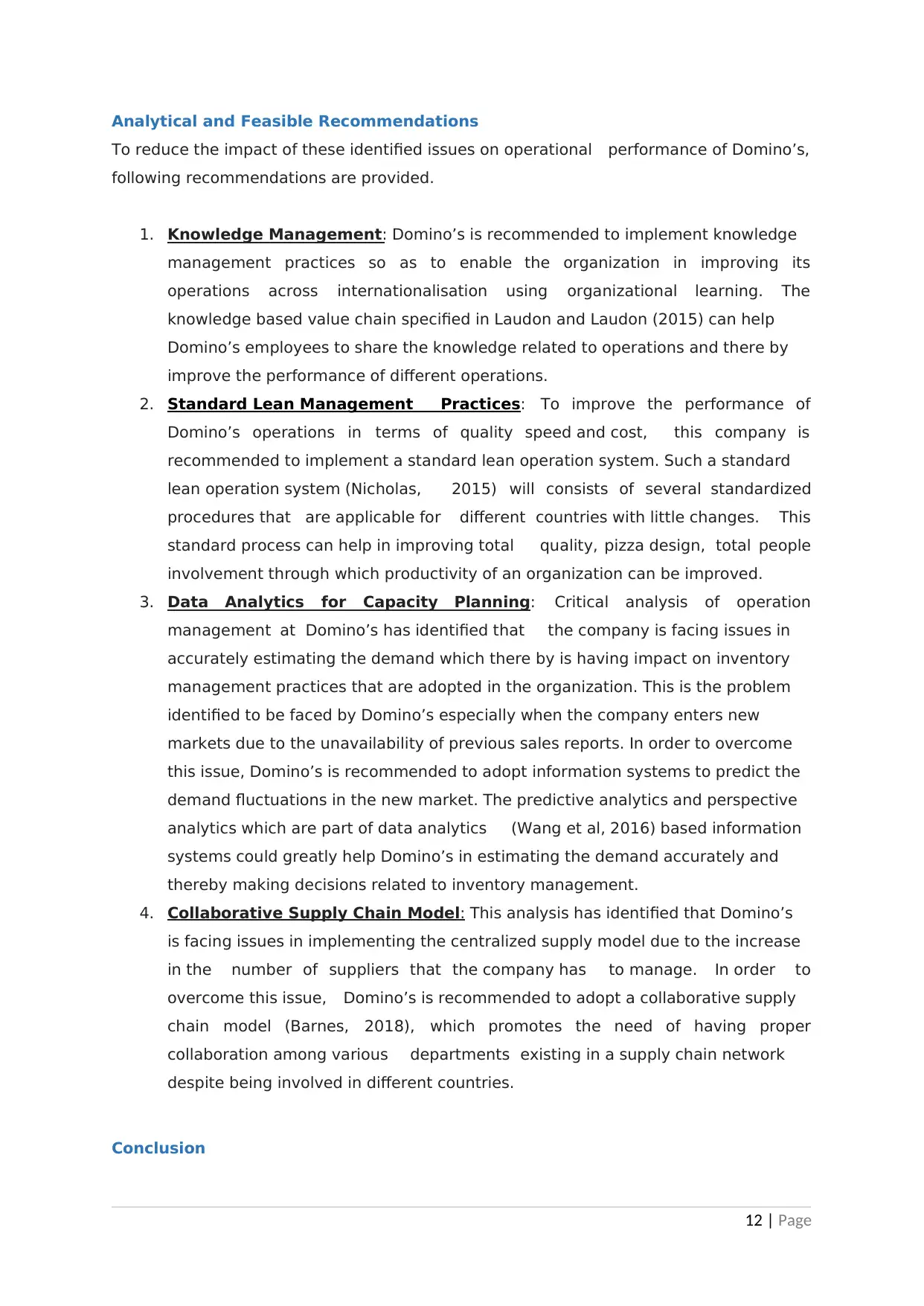
Analytical and Feasible Recommendations
To reduce the impact of these identified issues on operational performance of Domino’s,
following recommendations are provided.
1. Knowledge Management: Domino’s is recommended to implement knowledge
management practices so as to enable the organization in improving its
operations across internationalisation using organizational learning. The
knowledge based value chain specified in Laudon and Laudon (2015) can help
Domino’s employees to share the knowledge related to operations and there by
improve the performance of different operations.
2. Standard Lean Management Practices: To improve the performance of
Domino’s operations in terms of quality speed and cost, this company is
recommended to implement a standard lean operation system. Such a standard
lean operation system (Nicholas, 2015) will consists of several standardized
procedures that are applicable for different countries with little changes. This
standard process can help in improving total quality, pizza design, total people
involvement through which productivity of an organization can be improved.
3. Data Analytics for Capacity Planning: Critical analysis of operation
management at Domino’s has identified that the company is facing issues in
accurately estimating the demand which there by is having impact on inventory
management practices that are adopted in the organization. This is the problem
identified to be faced by Domino’s especially when the company enters new
markets due to the unavailability of previous sales reports. In order to overcome
this issue, Domino’s is recommended to adopt information systems to predict the
demand fluctuations in the new market. The predictive analytics and perspective
analytics which are part of data analytics (Wang et al, 2016) based information
systems could greatly help Domino’s in estimating the demand accurately and
thereby making decisions related to inventory management.
4. Collaborative Supply Chain Model: This analysis has identified that Domino’s
is facing issues in implementing the centralized supply model due to the increase
in the number of suppliers that the company has to manage. In order to
overcome this issue, Domino’s is recommended to adopt a collaborative supply
chain model (Barnes, 2018), which promotes the need of having proper
collaboration among various departments existing in a supply chain network
despite being involved in different countries.
Conclusion
12 | Page
To reduce the impact of these identified issues on operational performance of Domino’s,
following recommendations are provided.
1. Knowledge Management: Domino’s is recommended to implement knowledge
management practices so as to enable the organization in improving its
operations across internationalisation using organizational learning. The
knowledge based value chain specified in Laudon and Laudon (2015) can help
Domino’s employees to share the knowledge related to operations and there by
improve the performance of different operations.
2. Standard Lean Management Practices: To improve the performance of
Domino’s operations in terms of quality speed and cost, this company is
recommended to implement a standard lean operation system. Such a standard
lean operation system (Nicholas, 2015) will consists of several standardized
procedures that are applicable for different countries with little changes. This
standard process can help in improving total quality, pizza design, total people
involvement through which productivity of an organization can be improved.
3. Data Analytics for Capacity Planning: Critical analysis of operation
management at Domino’s has identified that the company is facing issues in
accurately estimating the demand which there by is having impact on inventory
management practices that are adopted in the organization. This is the problem
identified to be faced by Domino’s especially when the company enters new
markets due to the unavailability of previous sales reports. In order to overcome
this issue, Domino’s is recommended to adopt information systems to predict the
demand fluctuations in the new market. The predictive analytics and perspective
analytics which are part of data analytics (Wang et al, 2016) based information
systems could greatly help Domino’s in estimating the demand accurately and
thereby making decisions related to inventory management.
4. Collaborative Supply Chain Model: This analysis has identified that Domino’s
is facing issues in implementing the centralized supply model due to the increase
in the number of suppliers that the company has to manage. In order to
overcome this issue, Domino’s is recommended to adopt a collaborative supply
chain model (Barnes, 2018), which promotes the need of having proper
collaboration among various departments existing in a supply chain network
despite being involved in different countries.
Conclusion
12 | Page
⊘ This is a preview!⊘
Do you want full access?
Subscribe today to unlock all pages.

Trusted by 1+ million students worldwide
1 out of 14
Related Documents
Your All-in-One AI-Powered Toolkit for Academic Success.
+13062052269
info@desklib.com
Available 24*7 on WhatsApp / Email
![[object Object]](/_next/static/media/star-bottom.7253800d.svg)
Unlock your academic potential
Copyright © 2020–2025 A2Z Services. All Rights Reserved. Developed and managed by ZUCOL.





